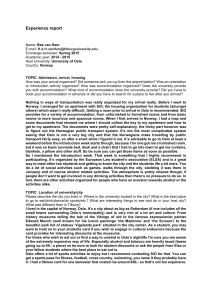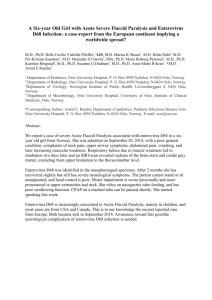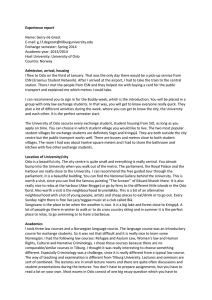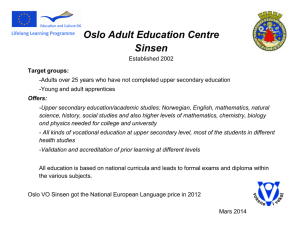Experience Report: Oslo University, Norway
advertisement
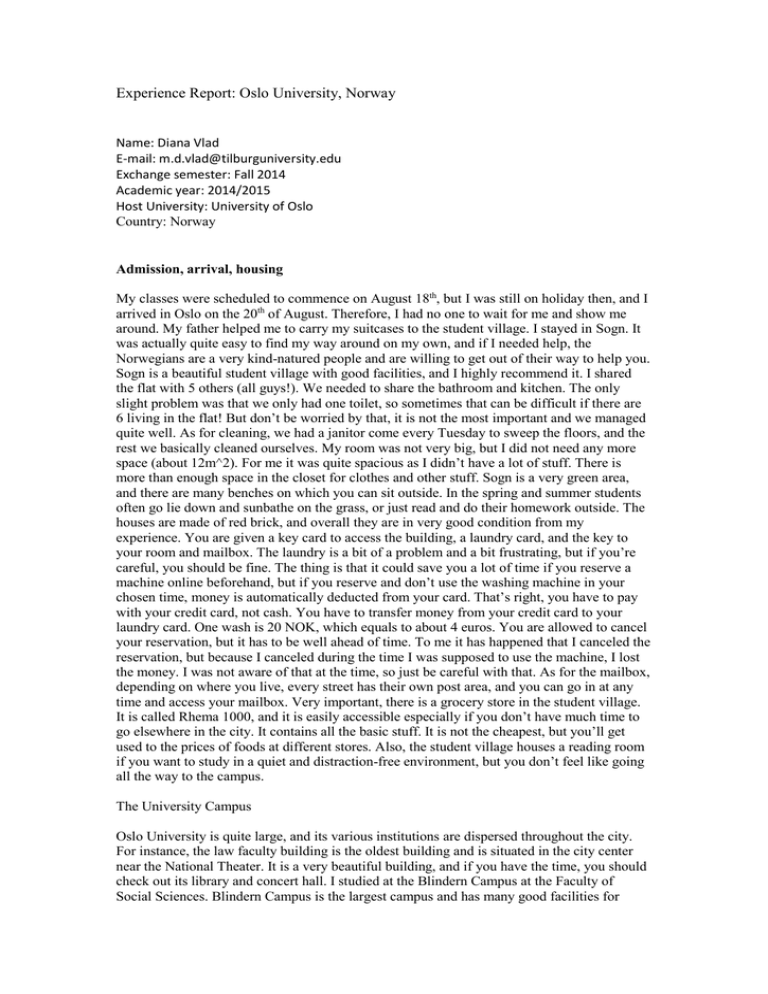
Experience Report: Oslo University, Norway Name: Diana Vlad E-mail: m.d.vlad@tilburguniversity.edu Exchange semester: Fall 2014 Academic year: 2014/2015 Host University: University of Oslo Country: Norway Admission, arrival, housing My classes were scheduled to commence on August 18th, but I was still on holiday then, and I arrived in Oslo on the 20th of August. Therefore, I had no one to wait for me and show me around. My father helped me to carry my suitcases to the student village. I stayed in Sogn. It was actually quite easy to find my way around on my own, and if I needed help, the Norwegians are a very kind-natured people and are willing to get out of their way to help you. Sogn is a beautiful student village with good facilities, and I highly recommend it. I shared the flat with 5 others (all guys!). We needed to share the bathroom and kitchen. The only slight problem was that we only had one toilet, so sometimes that can be difficult if there are 6 living in the flat! But don’t be worried by that, it is not the most important and we managed quite well. As for cleaning, we had a janitor come every Tuesday to sweep the floors, and the rest we basically cleaned ourselves. My room was not very big, but I did not need any more space (about 12m^2). For me it was quite spacious as I didn’t have a lot of stuff. There is more than enough space in the closet for clothes and other stuff. Sogn is a very green area, and there are many benches on which you can sit outside. In the spring and summer students often go lie down and sunbathe on the grass, or just read and do their homework outside. The houses are made of red brick, and overall they are in very good condition from my experience. You are given a key card to access the building, a laundry card, and the key to your room and mailbox. The laundry is a bit of a problem and a bit frustrating, but if you’re careful, you should be fine. The thing is that it could save you a lot of time if you reserve a machine online beforehand, but if you reserve and don’t use the washing machine in your chosen time, money is automatically deducted from your card. That’s right, you have to pay with your credit card, not cash. You have to transfer money from your credit card to your laundry card. One wash is 20 NOK, which equals to about 4 euros. You are allowed to cancel your reservation, but it has to be well ahead of time. To me it has happened that I canceled the reservation, but because I canceled during the time I was supposed to use the machine, I lost the money. I was not aware of that at the time, so just be careful with that. As for the mailbox, depending on where you live, every street has their own post area, and you can go in at any time and access your mailbox. Very important, there is a grocery store in the student village. It is called Rhema 1000, and it is easily accessible especially if you don’t have much time to go elsewhere in the city. It contains all the basic stuff. It is not the cheapest, but you’ll get used to the prices of foods at different stores. Also, the student village houses a reading room if you want to study in a quiet and distraction-free environment, but you don’t feel like going all the way to the campus. The University Campus Oslo University is quite large, and its various institutions are dispersed throughout the city. For instance, the law faculty building is the oldest building and is situated in the city center near the National Theater. It is a very beautiful building, and if you have the time, you should check out its library and concert hall. I studied at the Blindern Campus at the Faculty of Social Sciences. Blindern Campus is the largest campus and has many good facilities for students. The main library is very large, and is equipped with many study places and computers. There is also a cafeteria. Be alert during exam periods, as the library is packed, and if you want to go study there, you are only guaranteed a spot if you show up at 8 am when the library opens! I didn’t study too much at the library, but my favorite spot was on the third floor in one of the 2 upstairs quiet compartments (you’ll know what I mean when you see it). Other than that, all faculties also have their own study areas. Sometimes I went to study at the Eilert Sundts building which houses the social science faculty. Upstairs there are some reading rooms, computers, and individual study places. The building also has a good cafeteria downstairs . I also know about the science building. It is open also on weekends, and you do not need special access. The campus also has a book shop called Akademika, where you can buy all your curriculum. Keep in mind that you can also find a lot of the literature you need in the library. Many of the books at Akademika are quite expensive, it is Norway after all! But other than that, it is a very good shop, which also sells study supplies such as pens and notebooks. There is also a grocery store (Bunnepris) and a pharmacy. Frederikke is the biggest cafeteria, and you can check out their daily menu at www.sio.no. The Blindern Sports center is located near Frederikke. There are a few other sports centers throughout the city affiliated with the university, but I only know of the main ones: Blindern and Domus Athletica (located at Forsningsperken). To become a member you just need to select the duration you want to train (for 3 months you pay 800 NOK), and you have to pay a membership fee. With this membership you have guaranteed access to the fitness center and the swimming pool. If you want to join a class like martial arts or dance, then you have to pay an additional fee. It is all on www.sio.no. Courses I chose courses from the social science faculty since that would be closest to my bachelor. I chose North/South Development, Comparative Political Economy, and The Scandinavian Welfare Society-Contemporary Perspectives. I chose development because later for my master I want to specialize in international development, so I figured that would be a good introduction for later on. It was a pretty interesting course, and we had frequent seminars in small groups to keep it interactive. Comparative political economy was the most challenging course, mostly because I did not have such a course before, and I’m not too familiar with politics. But if you like politics, I would highly recommend it because it was grossly interesting. It was challenging because there were many articles we had to read on top of the textbook, and for the exam we had to memorize the main ideas of each author and be able to compare and contrast them. The Scandinavian welfare state was interesting as well, since most people believe that this is the ideal model and they would like to copy it and implement it into their countries, but in reality, it is actually not all that perfect. It is also a comparative course, comparing the Scandinavian welfare system with other systems such as the Anglican and East Asian ones. I found the class itself to be quite dull however, as there was mainly guest speakers for every lecture, and they simply read what was on the slides with no touch of enthusiasm, and for me that does not work so well. Therefore, I had to mostly do independent studying. The Norwegian system of education is quite different from any I have experienced. You are required to read a lot, and to be able to process and synthesize a lot of information. Two of my exams were 4 hours long, and one was 6 hours! The questions were overall pretty general, and you were required to go into depth and write as much as you know. This approach really tests your understanding, and not just your ability to memorize vast quantities of information. I think this is unique to Norway. The grading system is on a scale from A to F. My exams counted for 100% of the grade, though I did also have two assignments, but they were just graded as pass/fail. Overall, I felt like I learnt a lot. The teachers were generally good, although it was a bit difficult to approach them because there were so many students in the class. Transportation It is very easy to get around. I mostly used the T-bane (metro). You can buy a monthly pass with a student discount on the campus at the Bunnpris grocery store. It costs about 340 NOK. The tram is also very good, and the busses. The metro stops closest to Sogn Studentby. The City Oslo is a very beautiful, and well-arranged city. It gives a feeling of coziness and security. I unfortunately did not see much of the city, but there are many things to see and to visit. The Opera House is a gorgeous piece of architecture, so you should definitely go there. There is also the Nobel Peace Center, and its definitely worth a tour inside. The Munch museum is fascinating, housing the beautiful Madonna and the Scream. The famous ski jump is very beautiful at night, all filled with lights. At night, you must go a top a hill overlooking the whole city. It is unbelievable. It is dead quiet, but filled with so many lights. It is definitely a sight to behold! I wanted to go see the Viking Ship museum, but I didn’t get the chance. Its free entry for students! Oslo also has many beautiful parks worth the visit, from the world famous Vigelands Park, to Ekenberg Park, if you are looking for a stroll to relieve the stresses of the week, there are plenty to choose from. The city center has a lot of shops, you definitely wont have time to see them all! There are lots of souvenir shops, malls, and also lots of pubs and restaurants. For grocery shopping, I recommend you try Gronland. It is an Asian market located at Gronland T-bane station, and it has many products at relatively reasonable prices. There are products from East Asia, from the Middle East, and Eastern Europe. Normally, I did my grocery shopping either at Kiwi, or Rema. Kiwi has cheaper prices. There is also Ica, which has a bigger selection, and is also more expensive. Meat in Norway is very expensive, but the produce is in quite good condition and produced in a much more sustainable manner than in other countries, hence the higher price. While in Norway, it would be a pity for you to miss out on the fresh salmon. It is fished directly from the North Sea, and you can definitely taste the difference between a fresh salmon, and a processed salmon. Norway is fish country, so make it part of your menu! The People The Norwegians may be known as cold and aloof, but I myself did not really experience that. Originally from South Eastern Europe, I was definitely aware of the contrast between north and south. It is true that the Norwegians are more reserved, but that does not make them antisocial by any means. Like I’ve mentioned earlier, they tend to be very helpful and polite. They are also very athletic, and take good care of themselves. They are outdoor people, and like to spend time going for walks, jogs, and of course skiing and hiking in the winter. I have made many good friends, mostly other international students, but I have known some Norwegians as well. In fact, one of my Norwegian roommates has turned out to be my significant other! You never know where your life takes you. That’s why you should take the risk and go on this exchange. Explore, learn, discover! To Future Students I definitely recommend Oslo University as an exchange destination. It has a wide selection of courses to choose from, it is a beautiful city with wonderful people. It is also relatively safe and secure, which makes it easier if it is your first time living on your own. Living in a totally different country on your own may at first seem like a daunting experience, but you are guaranteed, despite any difficulties you may encounter, that you will have an unforgettable learning experience, firstly about yourself, and secondly about the wild world that surrounds us. Enjoy! Diana Vlad

